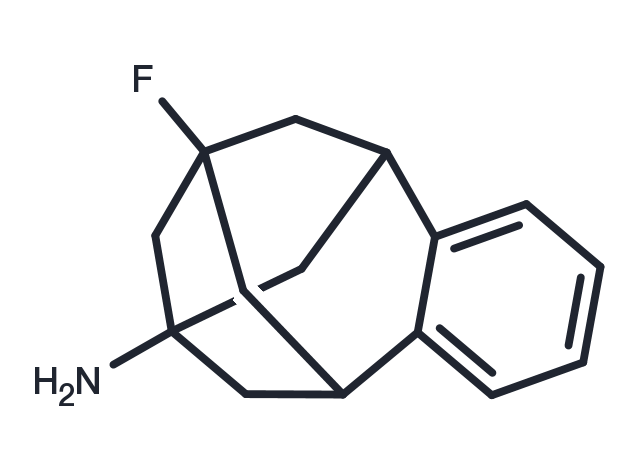Powder: -20°C for 3 years | In solvent: -80°C for 1 year


NMDA receptor antagonist 4 (IIc) is an uncompetitive, voltage-dependent, orally active NMDAR blocker, with an IC 50 of 1.93 μM. NMDA receptor antagonist 4 shows a positive predicted blood-brain-barrier (BBB) permeability, and can be used in Alzheimer's disease research[1].

| Pack Size | Availability | Price/USD | Quantity |
|---|---|---|---|
| 25 mg | 6-8 weeks | $ 1,520.00 | |
| 50 mg | 6-8 weeks | $ 1,980.00 | |
| 100 mg | 6-8 weeks | $ 2,500.00 |
| Description | NMDA receptor antagonist 4 (IIc) is an uncompetitive, voltage-dependent, orally active NMDAR blocker, with an IC 50 of 1.93 μM. NMDA receptor antagonist 4 shows a positive predicted blood-brain-barrier (BBB) permeability, and can be used in Alzheimer's disease research[1]. |
| In vitro | NMDA receptor antagonist 4 (IIc) exhibits competitive interaction with endogenous blocker Mg 2+, and exhibits dependence on membrane potential in the NMDAR channel [1]. NMDA receptor antagonist 4 shows high metabolic stability in human and mice liver microsomes, and shows hERG safety, without obvious cytotoxicity [1]. Cell Cytotoxicity Assay [1] Cell Line: Neuro2A cells Concentration: 1, 10, and 100 μM Incubation Time: 24 h Result: Did not show cytotoxic at the highest concentration tested (100 μM). |
| In vivo | NMDA receptor antagonist 4 (IIc) demonstrated significant neuroprotective effects in both in vitro and in vivo models at concentrations of 0-10 μM, reducing motor deficits and protecting against Aβ toxin-induced neuronal dysfunction. Furthermore, when administered orally at a dose of 5 mg/kg/day for four weeks, it enhanced cell survival and synaptic function in Alzheimer's disease models. This improvement is attributed to the activation of cell-survival signaling pathways, specifically Fyn-GluN2B-CREB signaling, and the prevention of synaptic NMDARs internalization. In C. elegans models (N2 wild-type, CL2006, CL2122, CL2355), varying doses (0, 0.1, 0.5, 1.5, and 10 μM) ameliorated defective locomotion in CL2006 nematodes and significantly improved chemotaxis behavior in CL2355 nematodes affected by Aβ expression. In six-month-old female 5XFAD mice, the same treatment regimen enhanced working memory function, restored the expression of GluN2A and postsynaptic density protein (PSD) 95, led to an increase in Fyn and GluN2B phosphorylation, significantly raised p-CREB protein levels in the nucleus, and reverted calbindin D-28K protein levels. |
| Molecular Weight | 231.31 |
| Formula | C15H18FN |
| CAS No. | 1607589-56-9 |
Powder: -20°C for 3 years | In solvent: -80°C for 1 year
You can also refer to dose conversion for different animals. More
bottom
Please see Inhibitor Handling Instructions for more frequently ask questions. Topics include: how to prepare stock solutions, how to store products, and cautions on cell-based assays & animal experiments, etc.
NMDA receptor antagonist 4 1607589-56-9 inhibitor inhibit
